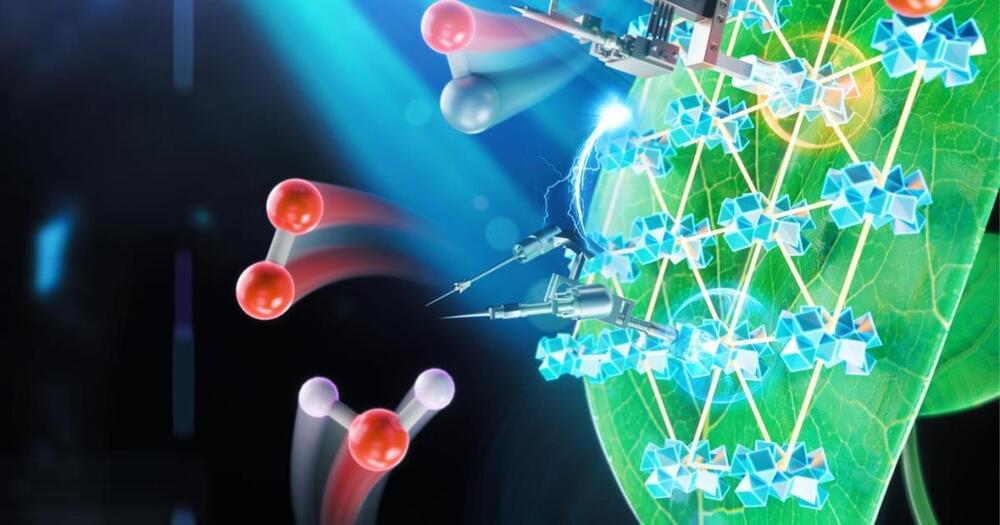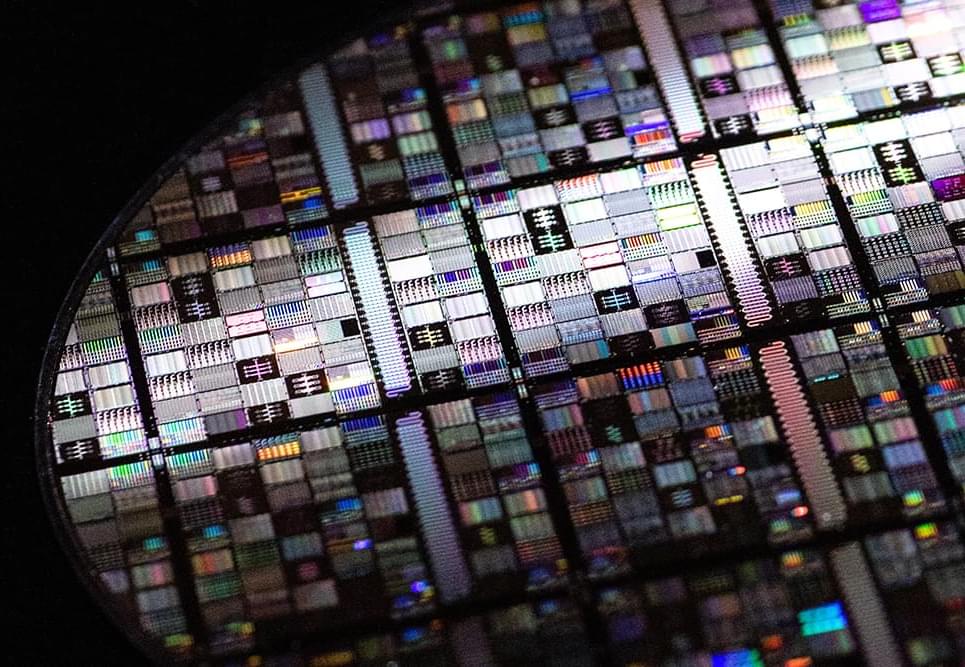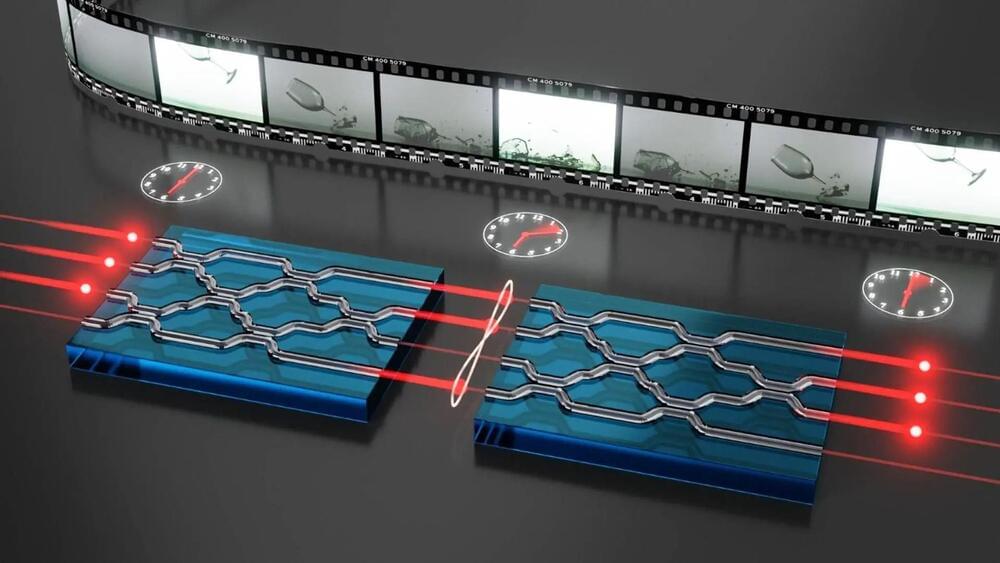A group of 51 superconducting qubits have been entangled inside a quantum computer, not just in pairs but in a complex system that entangles each qubit to every other one.


A group of 51 superconducting qubits have been entangled inside a quantum computer, not just in pairs but in a complex system that entangles each qubit to every other one.

The quantum nature of interactions between elementary particles allows drawing non-trivial conclusions even from processes as simple as elastic scattering. The ATLAS experiment at the LHC accelerator reports the measurement of fundamental properties of strong interactions between protons at ultra-high energies.
The physics of billiard ball collisions is taught from early school years. In a good approximation, these collisions are elastic, where both momentum and energy are conserved. The scattering angle depends on how central the collision was (this is often quantified by the impact parameter value—the distance between the centers of the balls in a plane perpendicular to the motion). In the case of a small impact parameter, which corresponds to a highly central collision, the scattering angles are large. As the impact parameter increases, the scattering angle decreases.
In particle physics, we also deal with elastic collisions, when two particles collide, maintaining their identities, and scatter a certain angle to their original direction of motion. Here, we also have a relationship between the collision parameter and the scattering angle. By measuring the scattering angles, we gain information about the spatial structure of the colliding particles and the properties of their interactions.


Advancing the state of the art in superconducting qubit hardware requires knowledge across a range of disciplines, including materials, fabrication, circuit design and simulation, packaging, cryogenics, low-noise measurement, hardware-software interfacing, and quantum compilation. As understanding of materials and processes has advanced over time, fabricating the highest-quality qubits increasingly relies on millions of dollars of fabrication equipment and countless hours of process development and sustainment.
“It has become increasingly challenging for individual organizations to maintain this full stack of expertise, particularly as circuits become more complex to design, fabricate, and measure,” Schwartz says. “As a result, superconducting qubit hardware research has remained centralized into a relatively small number of laboratories and large universities capable of developing and sustaining this expertise.”
MIT Lincoln Laboratory is one of these laboratories, with more than 20 years of research and development in superconducting qubits and demonstrations of world-leading qubit performance. The qubits are made on-site at the Microelectronics Laboratory, considered to be one of the U.S. government’s most advanced foundries, and in specialized prototyping facilities. The collective expertise and equipment of this facility have made it possible to stand-up the SQUILL Foundry.

An international team of physicists has succeeded in measuring a property of the electron known as topological spin winding for the first time. The team obtained this result by studying the behaviour of electrons in so-called kagome metals, which are materials that have unique quantum properties related to their physical shape, or topology. The work could advance our understanding of the physics of superconductors and other systems that contain strongly correlated electrons.
Kagome metals are named after a traditional Japanese basket-weaving technique that produces a lattice of interlaced, symmetrical triangles with shared corners. When the atoms of a metal or other conductor are arranged in this kagome pattern, their electrons behave in unusual ways. For example, the wavefunctions of the electrons can interfere destructively, resulting in highly localized electronic states in which the particles interact strongly with each other. These strong interactions lead to a range of quantum phenomena, including magnetic ordering of unpaired electrons spins that can produce, for example, ferro-or antiferromagnetic phases, superconducting structures, quantum spin liquids and abnormal topological phases. All these phases have applications in advanced nanoelectronics and spintronics technologies.
In the new work, researchers led by Domenico Di Sante of the University of Bologna in Italy studied the spin and electronic structure of XV6Sn6, where X is a rare-earth element. These recently-discovered kagome metals contain a Dirac electronic band and a nearly flat electronic band. At the point at which these bands meet, an effect called spin-orbit coupling creates a narrow gap between the bands. This spin-orbit coupling also creates special type of electronic ground state at the material’s surface.

It seems quantum mechanics and thermodynamics cannot be true simultaneously. In a new publication, University of Twente researchers use photons in an optical chip to demonstrate how both theories can be true at the same time.
In quantum mechanics, time can be reversed and information is always preserved. That is, one can always find back the previous state of particles. It was long unknown how this could be true at the same time as thermodynamics. There, time has a direction and information can also be lost. “Just think of two photographs that you put in the sun for too long, after a while you can no longer distinguish them,” explains author Jelmer Renema.
There was already a theoretical solution to this quantum puzzle and even an experiment with atoms, but now the University of Twente (UT) researchers have also demonstrated it with photons. “Photons have the advantage that it is quite easy to reverse time with them,” explains Renema. In the experiment, the researchers used an optical chip with channels through which the photons could pass. At first, they could determine exactly how many photons there were in each channel, but after that, the photons shuffled positions.

“I find it totally amazing that it is possible at all to build these light structures.”
A Ph.D. candidate at has developed an innovative technique for creating the elementary building blocks of a future quantum computer or internet in a more controlled manner, opening up a potential solution to many of the challenges along the road to this long-sought technology.
Petr Steindl’s doctoral thesis, which he defended last week as the final step in his Ph.D. program at Leiden University in Germany, explores a new technique for generating photons using quantum dots and microcavities.

A controversial new type of electric propulsion system that physicists say defies Newton’s Laws of Motion, known as the Quantum Drive, has secured a spot on a SpaceX rocket and will launch into low Earth orbit (LEO) this October.
Designed by IVO Ltd., an electronics prototyping company, the promising yet controversial Quantum Drive could change the future of space travel and, if proven to work, would potentially rewrite or expand many of the accepted principles of inertia and motion that have existed for centuries.
Newtonian Physics Says creating inertia Without Propellant is Impossible.

Inside a lab, scientists marvel at a strange state that forms when they cool down atoms to nearly absolute zero. Meanwhile, just outside their window, trees are absorbing sunlight and converting it into new leaves. These two scenarios may seem entirely unrelated, but a recent study from the University of Chicago proposes that these processes are not as distinct as they might appear on the surface.
Published in the journal PRX Energy, the study established connections at the atomic level between the process of photosynthesis and exciton condensates, —a strange state of physics that allows energy to flow frictionlessly through a material. According to the authors, this discovery is not only fascinating from a scientific perspective, but it may also offer new perspectives for electronics design.

LOS ANGELES – Artificial intelligence, quantum computing and nuclear power are among the key technologies Lockheed Martin sees as important for future space missions.
Through a project called Destination: Space 2050, Lockheed Martin executives are exploring, for example, how AI could assist scientific exploration of locations where communications with remote sensors would be disrupted by high latency.
In that type of environment, “you really can’t interact with the robotic sensors,” David Lackner, Lockheed Martin senior manager strategy and business development, said during a June 28 webinar. “You have to have something that is super autonomous that can deal with unknown unknowns. We’ve got some really interesting causal autonomy tools that … allow the AI to be super smart about running into something that it hasn’t encountered before.”